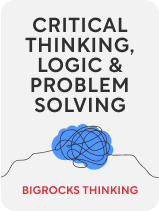

This article is an excerpt from the Shortform book guide to "Critical Thinking, Logic & Problem Solving" by Bigrocks Thinking. Shortform has the world's best summaries and analyses of books you should be reading.
Like this article? Sign up for a free trial here.
What’s the pyramid principle, and how can it help you present information effectively? What if you structured your presentations as stories?
The authors of Critical Thinking, Logic & Problem Solving explain how to give good presentations and communicate your ideas effectively using critical thinking. They note that many people have excellent ideas but don’t understand how to structure their presentations.
Read more to learn how to structure a presentation by structuring your thinking first.
How to Structure a Presentation
The authors advise you to structure your presentations logically and to use stories to persuade and inform your audience. However, before we get to their recommendations for how to structure a presentation, let’s look at their broad advice for any form of public speaking:
- Know your topic. A thorough understanding of your subject will establish credibility with your audience and help you answer questions they have.
- Know your audience. Be aware of your target audience’s demographics, interests, and beliefs, and appeal to those things to establish a bond with them.
- Make consistent eye contact. This will help you connect with your audience as well as gauge their reactions to what you’re saying.
- Ask questions of your audience. Asking questions keeps your audience engaged and focused on what you’re saying.
| Further Tips on Public Speaking Knowing your topic means not only knowing what information you’re going to give but also what objections or counterpoints might come up. You shouldn’t go into your talk with gaps in your knowledge because you assume the audience will know even less than you do. Knowing your audience can also include knowing the type of speaking you’re doing. Different formats allow for different methods of interacting with the audience and types of language to be used. For example, a teacher in a classroom can speak directly to students one-on-one and use vocabulary terms they’re studying. If you’re a speaker on a panel at a Comic Con, you can address not only your audience but also the other members of the panel, and you can use language from popular franchises the audience will be familiar with. Some experts suggest that eye contact is the most important thing you can practice to improve your speaking skills. It captures people’s attention, makes you look more confident, and keeps you from getting distracted. Questions can help you at every stage of your presentation. Even before you dive into your topic, consider asking questions to break the ice like “What did you do last weekend?” It can also help to use the 5Ws to frame your questions (What, When, Where, Who, Why), or to ask reflective questions that let the audience ponder what they’ve learned so far and apply it to what they’re learning now. |
The Pyramid Principle
According to the authors, structured thinking is key to effective communication. They recommend the pyramid principle for establishing this structure, which consists of the following three steps:
- Explain your main idea. This includes the problem you’re trying to solve and the solution you’re proposing.
- Explain your reasoning. Here you’ll let the audience in on your thought process, explaining what options you considered and why you chose your solution.
- Explain your evidence. Here you’ll give the details and facts that support the solution you chose.
(Shortform note: According to Barbara Minto, who coined the pyramid principle, the structure is effective because it mirrors the way the human brain works and presents information to the reader in the order that’s easiest for them to understand. However, she cautions that it may result in unoriginal thinking, detracting from your ability to draw new insights from the information. She also says it’s less effective for nuanced arguments that have multiple interpretations, as opposed to arguments with clear and definitive conclusions.)
How to Structure Stories
The authors place particular emphasis on storytelling, as it helps your audience understand and remember your ideas. It can also build an emotional connection, which further enhances their comprehension and retention. They recommend several ways to structure your stories depending on your goal.
To persuade others, they recommend the situation-complication-resolution approach. First, you explain the situation, then the complication (the problem), and then the solution that you’re recommending to them.
To explain information to your audience, you can use the hook-meat-payoff structure. First give your hook, where you pique their interest by letting them know what they can get out of your presentation. Follow that up with the meat, where you explain the topic you’re trying to get across to them. Finally, explain exactly how they can apply your information to their lives.
You can also structure your stories by breaking them into acts. One of the act structures the authors recommend is the five-act structure, or Freytag’s pyramid, which consists of:
- The exposition, which introduces the context and circumstances of the story
- The rising action, in which you describe the events leading to the conflict
- The climax, which is the high point of your plot when the conflict is greatest
- The falling action, where the conflict gets solved and the moral of the story is revealed
- The denouement, or the end of the story
Another framework they recommend is the Pixar story framework. This is great for not only conveying information and ideas but also evoking emotion. You can outline a story by filling in the blanks of six sentences:
- “Once upon a time, [blank]. Every day, [blank].”
- “Then one day, [blank].”
- “Because of that, [blank]. And because of that, [blank].”
- “Until finally, [blank].”

———End of Preview———
Like what you just read? Read the rest of the world's best book summary and analysis of Bigrocks Thinking's "Critical Thinking, Logic & Problem Solving" at Shortform.
Here's what you'll find in our full Critical Thinking, Logic & Problem Solving summary:
- A step-by-step guide for improving critical thinking and problem-solving skills
- Tips for conducting better research and finding reliable resources
- How to improve your communication and storytelling skills






